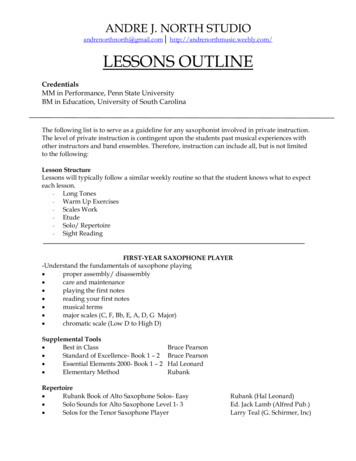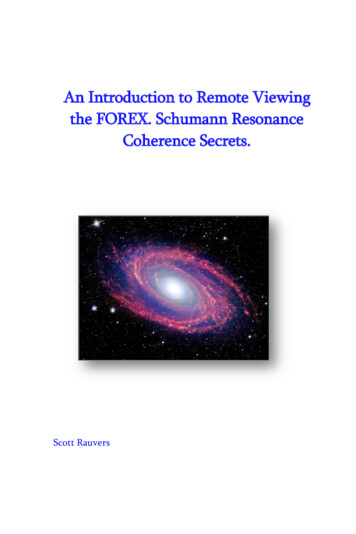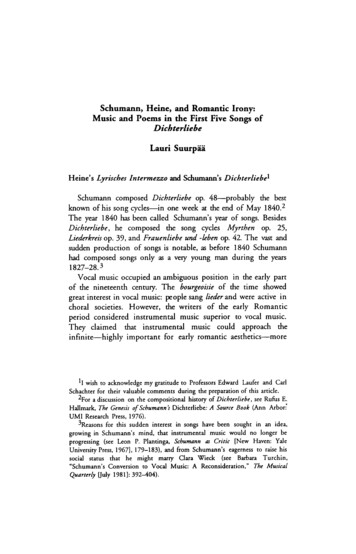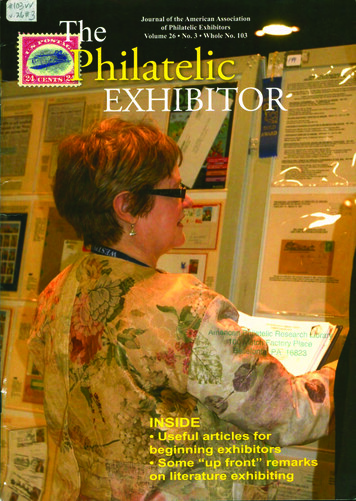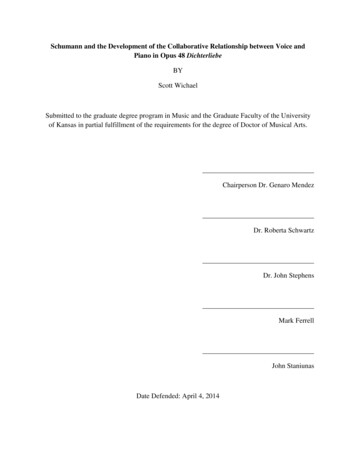
Transcription
Schumann and the Development of the Collaborative Relationship between Voice andPiano in Opus 48 DichterliebeBYScott WichaelSubmitted to the graduate degree program in Music and the Graduate Faculty of the Universityof Kansas in partial fulfillment of the requirements for the degree of Doctor of Musical Arts.Chairperson Dr. Genaro MendezDr. Roberta SchwartzDr. John StephensMark FerrellJohn StaniunasDate Defended: April 4, 2014
The Dissertation Committee for Scott Wichaelcertifies that this is the approved version of the following dissertation:Schumann and the Development of the Collaborative Relationship between Piano and Voice inOpus 48 DichterliebeChairperson Dr. Genaro MendezDate approved April 4, 2014ii
AbstractAfter Franz Schubert, Robert Schumann is the most recognized name as a composer ofLieder. The son of a book dealer Schumann was perhaps one of the most well read composers ofhis day, which resulted in informed decisions as to his choice of poetry and treatment of eachpoem within his songs and cycles. Schumann’s first foray into lieder in 1827-28 was followedby an over ten year hiatus from lieder composition. During this time he seemed to have a disdainfor vocal writing thinking it to be an “inferior” form of music and led to him solidifying hisinstrumental compositional technique.The year of 1840 to 1841, brought an abrupt change in his attitude about song compositionand he went on with what has been described as his Liederjahr, in which he composed over 150songs and several cycles including Dichterliebe, which combined Schumann’s mature pianotechnique to his choice of poetry. What resulted was a combination of voice and piano that wasmore of a symbiotic relationship then that of simple voice and accompaniment. BeforeSchumann, the piano and voice could exist independently of each other. The vocal line was oneaspect of the song, often the melody, and the piano was accompaniment providing harmony andtext painting. In the mature songs of Schumann, including Dichterliebe, the piano and voicewere dependent, more collaborative with each other as not previously seen.iii
ExamplespageExample 1. Franz Schubert, Gretchen am Spinnrade, mm 1-78Example 2. Franz Schubert, Die Forelle, mm1-89Example 3. Franz Schubert, Ständchen, mm1-1010Example 4. Franz Schubert, Winterreise “Auf dem Flusse”, mm 1-1411Example 5. Franz Schubert, Winterreise “Auf dem Flusse” mm 41-5012Example 6. Robert Schumann, Dichterliebe “Aus meinen Tränen spriessen”15Example 7. Robert Schumann, Dichterliebe “Ich will meine Seele tauchen”, mm 14-2216Example 8. Robert Schumann, Dichterliebe “Und wüssten’s die Blumen”, mm 30-3717Example 9. Robert Schumann, Dichterliebe “Hör’ ich das Liedchen klingen”, mm 4-918Example 10. Robert Schumann, Dichterliebe “Hör’ ich das Liedchen klingen”, mm 19-30 19Example 11. Robert Schumann, Dichterliebe “Ich hab’ im Traum geweinet”, mm 24-39 20Example 12. Robert Schumann, Dichterliebe “Die alten bösen Lieder”, mm 48-6722iv
Schumann and the Development of the Collaborative Relationship between Pianoand Voice in Opus 48 DichterliebeIn songs artistic souls first make each other’s acquaintance, the poet with the composer,and vice versa; they must be so constituted that the poet, were he a musician, wouldexpress himself in tones just as he has in words, and that the musician, were he a poet,would express himself in words as he has in his notes.Robert Schumann 1After Franz Schubert, Robert Schumann may be the most recognized name as a composerof Lieder. The son of a book dealer, Schumann was perhaps one of the most well-readcomposers of his day, which resulted in informed decisions as to his choice of poetry andtreatment of each poem within his songs and cycles. Schumann’s first foray into Lieder in 182728 was followed by a hiatus from song composition. During this hiatus, he questioned the worthof vocal writing, describing it as an inferior form of music, which led to him solidifying hisinstrumental compositional technique. The year of 1840 to 1841 brought an abrupt change, andhe entered what has been described as his Liederjahr; he composed over one-hundred-fifty songsand several cycles, including Dichterliebe, which connected Schumann’s mature pianocompositional technique to his choice of poetry. What resulted was symbiotic combination ofvoice and piano. Before Schumann, the piano and voice could almost exist independently ofeach other. The vocal line conveyed the poetic aspect of the song, often with the melody, andthe piano provided accompaniment, harmony, mood setting and text painting. In Schumann’smature songs, including Dichterliebe, the piano and voice were dependent upon and more1Rufus Hallmark, “The Poet Sings”, in German Lieder in the Nineteenth Century ed. By Rufus Hallmark (NewYork: Routledge, 2010), 92.1
collaborative with each other. In the words of Julia Perrey, “With Schumann after Schubert, theLied was given a genuine voice. Here, the voice of the poet no longer dominates the musicalsetting, but rather the poetic text fully becomes part of Schumann’s own voice. Neither musicalimitation of poetic content nor emotional or stylistic assimilation, the Schumann Lied is theutterance of someone able to make the words he set to music his own. In this regard, thedistinction between the role of the voice and the role of the piano should be made very clear.Although romantically ‘intertwined’, the relation between the two is complimentary as well ascontrasting.” 2In addition, Robert Schumann may have been among the best-read composers of theRomantic era. Growing up in Zwickau with his book-dealer father, literature was a significantpart of his development. At fifteen Schumann founded a literary club, where he and his friendsread poetry, novels, and plays. He wrote, “The most significant writers of just about everycountry were familiar to me.”3 Following his father’s death in 1826, Schumann found guidanceand support from a local music-loving couple. Agnes Carus intruduced him to the Lieder ofFranz Schubert and encouraged him to compose songs. His first attempts set texts by severalpoets that he would return to again in later years, including Goethe, Byron, and Kerner. Many ofthe songs were skilled imitations of Schubert. They tended to be strophic, but some were inABA form and a few were through-composed. All of the early songs, though, are texturallyhomophonic: voice and accompaniment. Although immature, the works show glimpses of what2Julia Beate Perrey, Schumann’s Dichterliebe and Early Romantic Poetics (Cambridge: Cambridge Universitypress, 2002), 52-33Hallmark, German Lieder in the Nineteenth Century, 92.2
is to come in his later works, with mature piano technique, including some very brief preludesand postludes, and vocal phrases anticipated or echoed in the piano.4The social life of the German middle class in the eighteenth century held singing and theplaying of songs in great importance. The accompaniment of these early Lieder was usually notoverly difficult to play and often doubled the voice. 5 In 1842 Schumann stated, “The composernames his songs ‘Lieder with Piano,’ and this is important. For the singing voice certainly is notsufficient in itself; it cannot carry out the task of interpretation unaided.”6The development of piano literature in the nineteenth century was an essential factor inthe growth of the Lied and the combination of voice, poetry and piano. As it was more flexibleand expressive, and capable of more dynamic contrast, composers became more aware of thepiano’s ability to express new musical effects and sounds.The publication of song and solo piano music developed into more important genres ofmusic in the nineteenth century; both Schubert and Schumann found their distinct compositionalvoices writing for the solo piano and each incorporated that skill into their approach to the Lied.7During his eleven-year break from composing Lieder, Schumann became well-known asa music critic after founding and writing for the Neue Zeitschrift für Musik (New Journal forMusic). His prevailing attitude regarding Lieder was that it was an inferior genre. In 1839,remarking to fellow critic, Herrmann Hirschbach, he said, “All my life I have rated songcompositions less important than instrumental music, and have never taken them for a great artform .But don’t tell anyone that!”8 His attitude may seem perplexing, especially considering4Jürgen Thym, “Schumann: Reconfiguring the Lied,” in The Cambridge Companion to the Lied, ed. James Parsons(Cambridge: Cambridge University Press, 2004), 120-22.5Lorraine Gorrell, The Nineteenth-Century German Lied (Portland: Amadeus Press, 1993), 57.6Gorell, The Nineteenth-Century German Lied, 58-61.7Gorell, The Nineteenth-Century German Lied, 62.8John Worthen, Robert Schumann: Life and Death of a Musician (New Haven: Yale University Press, 2007), 186.3
his literary background and inclination for writing. The combination of music and literature inhis life appears ideal for writing vocal works. According to Alan Walker, Schumann believedthat music was a form of language, that the composer had a duty to translate verse into music,and the music should not be lowered to the level of words. As a piano composer he haddeveloped his own language, and poetry could be an irrelevance or a rival. 9It is also important to understand that Schumann’s first and most influential attachment tomusic was with the piano. Piano was the instrument of his early experience, and he moved toHeidelberg in 1831 to become a piano virtuoso. Schumann thought in terms of the piano, andthus his connection to literature often took the form of programmatic keyboard music.10 Gorellstates, “Since the majority of Schumann’s piano pieces were written before his Lieder, he hadalready developed a highly individual pianistic language and knew this instrument’s potential forcolors and expressive range. In his songs, the piano often takes the lead in its partnership withthe voice.”11 In his Lieder he combined a mature compositional technique, personal sentiment,and complete literary knowledge into a fully formed unity of voice and piano.12During his break from Lieder, Schumann was influenced by an aesthetic that may bedescribed as the Romantic Fragment or “Fragmente” as described by Fredrich Schlegel, atheorist of the Romantic era. Schlegel suggested that the essence of Romantic art lays in thefragmentary; for instance, a sketch or short work, although incomplete, may imply a largerwhole. Despite not using the exact term “fragment” in an 1839 review of Chopin’s Preludes,Schumann wrote, “I would describe the Preludes as strange [T]hey are sketches, the beginningsof etudes, or if you will, ruins”. Many of his piano pieces and several of his later songs,9Alan Walker, ed. Robert Schumann: The Man and His Music (Great Britain: Barrie & Jenkins, 19721), 121.Leon B. Plantinga, Schumann as Critic (New Haven: Yale University Press, 1967), 179-80.11Gorrell, The Nineteenth-Century German Lied, 71.12Richard Miller, Singing Schumann (New York: Oxford University Press, 1999), 8.104
including “Im wunderschönen monat Mai” from Dichterliebe, incorporate the “fragment”aesthetic.13By 1840, Schumann had developed and mastered his technique of composing for thepiano. At this time he suddenly returned to composing Lieder. The shift may be attributed toseveral factors. It was in 1840 that Schumann fought Friedrich Wieck in court for the right tomarry Wieck’s daughter, Clara. Despite his confidence that he would win, Schumann felt hemust address the primary objection that Wieck had with him, his lack of income. Lieder was themost marketable genre in Germany at the time, and successful songs could provide financialstability for the couple. From May 1840 to September 1841, his Liederjahr, Schumanncomposed over 150 songs in several sets. Another factor was the prospect of marrying Clara,his muse. “Much of you is embedded in my Eichendorff Liederkreis,” he wrote to Clara in Mayof 1840.14“I feel like singing myself to death, like the nightingale. There are twelve Eichendorffsongs, but I have already forgotten them and started something new,” Schumann wrote to Clarain May of 1840. The “something new” was Dichterliebe, a cycle of sixteen songs setting poemsby Heinrich Heine.15 The poems in Dichterliebe (A Poet’s Love) are from Heine’s LyrischesIntermezzo, a set of sixty-six poems written in 1822-23. The overall theme of Dichterliebe isone of unrequited love, and it may have been Schumann’s difficulty in marrying Clara thatinspired this cycle.Originally, the cycle was comprised of twenty songs and titled Gedichte13Hallmark, German Lieder in the Nineteeth Century, 100-01.John Daverio, Robert Schumann: Herald of a “New Poetic Age” (New York: Oxford University Press, 1997),202-3.15Ronald Taylor, Robert Schumann: His Life and Work (New York, Granada, 1982), 187.145
von Heinrich Heine, 20 Lieder und Gesänge aus dem lyrischen Intermezzo. Four of the songswere removed and the title Dichterliebe was added at the time of publication in 1844.16In order to understand Schumann’s new development of the singer and accompanistrelationship, one must take into account previous Lieder, particularly those of Franz Schubert.Over the course of his career, Schubert composed over 600 Lieder and many can beassigned to a few basic types. The strophic Lied contains an unchanging vocal line andaccompaniment from stanza to stanza. The modified strophic Lied uses a slightly altered melodyin the reprise. The scenic Lied contains contrasting sections that vary keys and tempi. Some ofthe scenic Lieder are in a modified ABA form. Finally, there is the durchkomponiert, throughcomposed song.17Schubert was the first important composer to concentrate a significant portion of his timeto the composition of Lieder. He added a level of artistry to and showed that Lieder could be achallenging and sophisticated genre.18 Schubert dedicated his time to devising memorablemelodies and emphasizing the meaning of the images in poetry with an expressive vocal line,musical texture, and harmony. 19The Schubert Lieder may be viewed as a construction on three different levels: the voiceand the two hands of the piano. The voice usually contains the melody. One hand of the pianowill incorporate an accompaniment figure, such as repeated chords, while the other handcontains a melodic or rhythmic motive associated with the vocal line. The motive can vary asthe Lied progresses. Several of Schubert’s most well known Lied including; Gretchen am16Arthur Komar, ed., Robert Schumann: Dichterliebe (New York: W.W. Norton & Company, 1971), 4.Dietrich Fischer- Dieskau. Schubert’s Songs, A Biographical Study, (New York: Alfred A Knopf, Inc., 1981), 7.18Gorrell, The Nineteenth-Century German Lied, 109.19Kristina Muxfeldt, “Schubert’s songs: the transformation of a genre” in The Cambridge Companion to Schubert,ed. Christopher Gibbs (Cambridge: Cambridge University Press, 1997), 123.176
Spinnrade, Erlkönig and Die Forelle, contain these three distinct features. 20 It is a mistake todescribe the accompaniment as simple support of the vocal line. It is better to think of the vocalline and the accompaniment as two voices on different planes. 21One of the most characteristically Schubertian strategies from the earliest songs to someof the latest is the representation of an inner experience through an analogy with someoutward physical motion or sound. There are countless familiar examples: Gretchen’sincreasing distraction from her activity as she remembers Faust is given a measurablepresence through the astonishingly realistic representation of the action of the spinningwheel, ceasing to spin at her climactic memory of his kiss. In Gute Nacht, as elsewherein Winterseisse, the plodding steps of the poet-wanderer, called up by the insistentlyplodding rhythm, force the events of the cycle into the present, heightening the emotionalforce of his departure ”22As Muxfeldt describes, Schubert incorporated highly stylized onomatopoeia, music thatis descriptive, but not simple text painting, and never a means unto itself. 23 Schubert uses anindividual ability to create patterns with harmony, melody and rhythm that work as symbols forpoetic ideas. Essentially he creates an accompaniment that embodies the mood or illustrates abackground idea to support the poem. Grey states, “That is, he invents musical ideas, usuallyaccompaniment motives and figures, which perfectly conform to one’s idea of the object withlittle or no attempt at musical description.”24Written in October of 1814, Gretchen am Spinnrade is one of the earliest and best knownexamples of how Schubert used the piano to provide onomatopoeia to accompany the narrativeof the vocal line. The right hand of the piano contains the sixteenth-note groupings thatsymbolize the incessant movement of Gretchen’s spinning wheel.The piano, while on a20Walter Gray, “The Classical Nature of Schubert’s Lieder, ”The Musical Quarterly, Vol 57, No, 1 (Jan., 1971):67Richard Capell, Schubert’s Songs (New York: The Macmillan Company, 1957), 38.22Kristina Muxfeldt, cited in Gibbs, The Cambridge Companion To Schubert, 131-2.23Hallmark. German Lieder in the Nineteeth Century, 40.24Gray, The Classical Nature of Schubert’s Lieder, 68-69.217
separate plane, does not double the voice; instead, it provides a depth of texture to the throbbingvocal line.25Example 1: Schubert, Gretchen am Spinnrade, mm. 1-726One of Schubert’s most popular Lieder is Die Forelle. It was first published as asupplement in a magazine in 1820 and then again in 1825 as his Opus. 32. Die Forelle isessentially strophic and has a modest, folksong-like vocal line. The piano is assigned a sextupletfigure that illustrates a trout and its swimming in a stream. 2725Kenneth Whitton, The Development of the German Lied (London: Julia MacRae, 1984), 35.Examples 1-5 from, Franz Schubert, 200 Songs in Three Volumes, Vol. 1. Sergius Kamen ed. (New York:International Music Company174.27Capel, Schubert’s Songs, 136268
Example 2: Schubert, Die Forelle, mm. 1-8In Ständchen, the accompaniment provides a feeling of palpitation with a repeatingeighth-note figure representing the strumming of a guitar. The piano echo, which represents thecontinuing thought of the vocal line, plays a significant role in Ständchen. (See Example 3)Written in 1827, Winterreise is Schubert’s most profound and lengthy work for voice.Comprised of 24 Lieder, Winterreise, is a cycle that represents lost or unrequited love, yet eachsong can be performed individually.28 It was with this cycle that Schubert continued to expandthe role of the piano. As Susan Youens states, “Winterreise is chamber music in which thepianist’s part far surpasses the subordinate function implied in the word ‘accompaniment.’28Susan Youens, Retracing a Winter’s Journey: Schubert’s Winterreise (Ithaca: Cornell University Press, 1991),73.9
Example 3. Schubert, Ständchen, mm. 1-10Ultimately, what is most impressive about the writing for the piano in this cycle is the pianist’srole both in the enactment of the poetry and in music’s inevitable antagonism to words.”29 Theseventh Lied of the cycle, Auf dem Flusse, is about a frozen river and how the poet will carve thedate he met his beloved and her name into the ice. The frozen river is a metaphor for his coldhart that still beats, but only under the frozen surface. The piano line is punctuated by weak-beataccents that exemplify emotional turmoil and unrest.30 In the final stanza, Schubert incorporatesthe original vocal melody in a new fashion. He brings back the vocal line but places it in the lefthand of the piano, as if attempting to bring the singer back to the previous melody, but he refusesto return to his previous state.2930Ibid, 107.Ibid, 108.10
Example 4. Schubert, Auf dem flusse, mm. 1-1411
Example 5. Schubert, Auf dem flusse, mm.41-50While each of these Lieder are excellent examples of the developing collaboration ofvoice and piano, the two elements are not on an equal plane and are not completely dependent oneach other. The vocal line takes precedence, while the piano incorporates the use ofonomatopoeia to comment on and support the poetic idea.Following Schubert’s Winterreise, Schumann’s Dichterliebe is counted as a pinnacle inthe development of the lied. Schumann did not entirely depart from Schubert’s approach to the12
Lied. Instead, he built on Schubert’s method of combining a beautiful vocal line with a virtuosopiano accompaniment. Schumann compared his Lieder to Schubert’s:Paralleling the development of poetry, the Franz Schubert epoch has already beenfollowed by a new one which has utilized the improvements of the simultaneouslydeveloped instrument of accompaniment, the piano . The voice alone cannot reproduceeverything or produce every effect; together with the expression of the whole the finerdetails of the poem should also be emphasized.31During his Liederjahr, Schumann composed many of his songs in such a way that thevocal line could be considered redundant as far as overall musical completeness. 32 RonaldTaylor states, “The watershed in Schumann’s creative life becomes the more prominent with therealization that what at first appears as a substantial change of interest from piano music to songrepresents in fact, as Schumann conceived the two genres, merely an organic extension of asingle lyrical continuum. The lyricism of his piano pieces is the lyricism of the Lied And aspoetry and music are but two designations of a single creative activity so the sphere ofinstrumental music merges in the sphere of vocal music.” 33In the first song of the cycle, “Im wunderschönen monat Mai,” the idea of the Romanticfragment is displayed. In many of his cycles, as well as in Carnival, Op. 9, individual songs orpieces seem to begin in the middle of things and to seem unfinished. By itself, “Imwunderschönen monat Mai” does not actually resolve, as it ends on an incomplete cadence. Theresolution only arrives by continuing on to the next song in the cycle, “Aus meinen Tränenspriessen.”31Richard Miller. Singing Schumann (New York: Oxford University Press, 1999), 7.Stephen Walsh, The Lieder of Schumann (London: Cassell & Company, 1971), 6.33Taylor, Ronald. Robert Schumann: His Life and Work (New York: Granada, 1982), 191.3213
In essence, the piano part in these songs is not an “accompaniment” but a part of the songitself, with the piano pointing, underlining, and conceptualizing the poetry.34 The result is afuller relationship between voice and piano, each with a role that complements the other. Thisallows Schumann to release the piano from having to accompany or provide text painting for thesinger and permits it to comment with interior or ulterior emotional suggestion on the poemarticulated by the singer. For example, in “Aus meinen Tränen spriessen,” three of the cadencesin the vocal line end on a dominant seventh chord and are answered and resolved in the piano.(See Example 6)Postludes play a vital part in Schumann’s songs and the relationship between voice andpiano. In Lieder prior to Schubert and early Schumann, the postlude’s function was normally tosummarize or punctuate the Lied. Yet several postludes in Dichterliebe introduce new materialand the postlude of the final Lied, “Die alten bösen Lieder,” is of such length and quality that itsummarizes both the final Lied and the complete cycle.35Example 6. Schumann, Aus meinen Tränen spriessen, mm 1-163435Taylor, Robert Schumann: His Life and Work, 192.Joan Chissell, Schumann (New York: Farrar, Strauss and Cudaby Inc.,), 142.14
15
36The fifth song in Dichterliebe, “Ich will meinen Seele tauchen,” contains a patternedaccompaniment that only alludes to the melody. When the voice concludes, the melody seemsincomplete; the piano then continues, completing and finalizing the poetic idea.37Example 7. Schumann, Ich will meine Seee tauchen, mm. 14-22Number eight in the cycle, “Und wüssten’s die Blumen,” is a strophic song. The poetlaments that only she may know his pain, as it was she who tore his heart in two. After a bitter36Examples 6-12 from, Schumann: 85 Songs, ed. Sergius Kamen (New York: International Music Company), 52.Dietrich Fischer-Dieskau, Robert Schumann Words and Music: The Vocal Compositions (Portland: AmadeusPress, 1981), 83.3716
vocal cadence, the piano then introduces new material which accents the indignant theme of thesong.38Example 8. Schumann, Und wüssten’s die Blumen, mm. 30-37In “Hör’ ich das Liedchen klingen,” the tenth song of the cycle, the piano introduction isa descending arpeggio with an offbeat dotted rhythm that tearfully presents what the voice will38Walsh, The Lieder of Schumann, 45-6.17
sing.39 In the postlude, Schumann subtly interweaves the voice and piano using the melody ofthe line “das einst die Liebst sang” (was sung by the beloved) repeating it several times as areminder of the poets former bliss now painfully gone.Example 9. Schumann, Hör’ ich das Liedchen klingen, mm. 4-939Miller, Singing Schuman. 109.18
Example 10. Schumann, Hör’ ich das Liedchen klingen, mm. 19-30In number thirteen, “Ich hab’ im Traum geweinet,” an interesting relationship betweenvoice and piano develops. During the first two stanzas of the poem, the voice and piano remaincompletely separate. One is silent while the other sounds. The voice comments first and ismournful and legato with a recitative quality. The piano punctuates the voice part with astaccato shudder. It is in the third and final stanza where the two come together. This time thepiano enters first, then the monotone vocal line joins the piano, which contains chords that do not19
resolve until the end of the piece.40 In the postlude the pianist has the responsibility to sustainsuspense by maintaining two long silences, one of eight beats and the other ten.Example 11. Schumann, “Ich hab im Traum geweinet,” mm. 24-39Perhaps the most famous postlude in all Lieder is that of the final song of the cycle, “Diealten bösen Lieder.” The final stanza of the poem is the poet proclaiming his intention to bury40Thym, “Schumann: Reconfiguring the Lied,” 130.20
all his love and anguish within a coffin so large that the only grave wide and deep enough for itis the ocean. Schumann makes the final statement of the cycle textless. The piano completesthe musical and poetic idea of the cycle by burying the poet’s grief with the descending motivethat represents the sinking of the coffin into the sea. “The expression of the ‘inexpressible’ hasbecome the responsibility of music.”41 (See Example 12)Robert Schumann incorporated his love for both literature and the piano into his Lieder.After his prolonged break from writing Lieder, in which he developed his piano technique andwas exposed to the aesthetics of the Romantic era, he then composed some of the most finelycrafted songs of the Romantic era. Before Schumann, the piano and voice functioned together,but on different planes, and while the piano supported of the voice, it was not its equal. InSchumann’s works, the piano became a textless voice which shared and in many instancespunctuated the vocal line. What resulted was a more collaborative relationship between voiceand piano.Example 12. Schumann, “Die alten bösen Lieder,” mm. 48-6741Smeed, J.W. German Song and its Poetry: 1740-1900 (New York: Croom Helm, 1987), 120-21.21
22
BibliographyBrody, Elaine and Robert A. Fowkes. The German Lied and Its Poetry. New York: New YorkUniversity Press, 1971.Brown, Thomas Allan. The Aesthetics of Robert Schumann. New York: Philosophical Library,1968.Capell, Richard. Schubert’s Songs. New York: The Macmillan Company, 1957.Daverio, John. Robert Schumann: Herald of a “New Poetic Age”. New York: Oxford UniversityPress, 1997.Fischer-Dieskau, Dietrich. Robert Schumann Words and Music: The Vocal Compositions.Translated by Reinhard G. Pauly. Portland:Amadeus Press, 1981.Fischer-Dieskau, Dietrich. Schubert’s Songs: A Biographical Study. New York: Alfred A.Knopf. 1981Gorell, Loraine. The Nineteenth-Century German Lied. Portland: Amadeus Press, 1993.Hallmark, Rufus, ed. German Lieder in the Nineteenth Century. New York: Routledge, 2010.Komar, Arthur, ed. Robert Schumann: Dichterliebe. New York: W.W. Norton & Company,1971.Moore, Gerald. Poet’s Love: The Songs and Cycles of Schumann. London: Hamish Hamilton,1981Muxfeldt, Kristina. “Schubert’s songs: the transformation of a genre,” in The CambridgeCompanion to Schubert. Edited by Christopher H. Gibbs. Cambridge: CambridgeUniversity press, 1997.23
Parsons, James, ed. The Cambridge Companion to the Lied. Cambridge: Cambridge UniversityPress, 2004. You seem to have mostly cited the Thym chapter, so you should cite it.Perrey, Beate Jula. Schumann’s Dichterliebe and Early Romantic Poetics: Fragmentation ofDesire. Cambridge: Cambridge University Press, 2002.Plantinga, Leon B. Schumann as Critic. New Haven: Yale University Press, 1967.Schubert, Franz. 200 Songs in three volumes, edited by Sergius Kagen, volume 1. New York:International Music Company.Schumann, Robert. 85 Songs, edited by Sergius Kagen. New York: International MusicCompany.Smeed, J. W. German Song and its Poetry 1740-1900. New York: Croom Helm, 1987.Stein, Jack M. Poem and Music in the German Lied from Gluck to Hugo Wolf. Cambridge:Harvard University Press, 1971.Taylor, Ronald. Robert Schumann: His Life and Work. New York: Granada Publishing Limited,1982.Walker, Alan, ed. Robert Schumann: The Man and His Music. Great Britain: Butler & JenkinsLtd., 1972.Whitten, Kenneth. Lieder: An Introduction to German Song. New York: Julia MacRae. 1984.Worthen, John. Robert Schumann: Life and Death of a Musician. New Haven: Yale UniversityPress, 2007.Youens, Susan. Retracing a Winter’s Journey: Schubert’s Winterriese. Ithaca: CornellUniversity Press, 1991.24
Lied was given a genuine voice. Here, the voice of the poet no longer dominates the musical setting, but rather the poetic text fully becomes part of Schumann's own voice. Neither musical imitation of poetic content nor emotional or stylistic assimilation, the Schumann Lied is the utterance of someone able to make the words he set to music .





